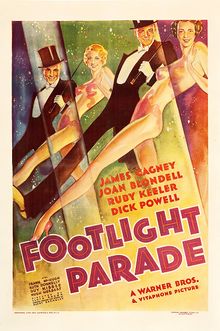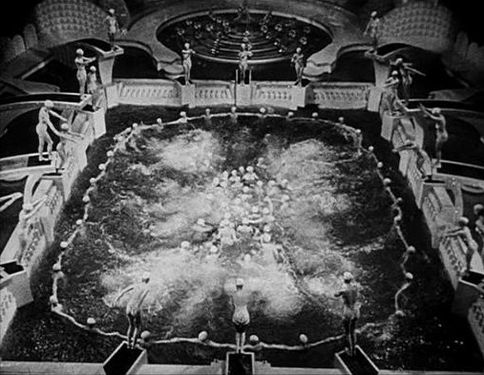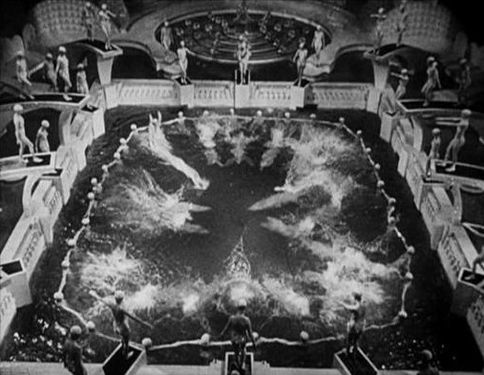Footlight Parade: Difference between revisions
(Created page with "{{Header|Footlight Parade 04/24}} {{Infobox film | name = Footlight Parade | image = Footlight_Parade_(1933_theatrical_poster).jpg | caption = Original 1933 theatrical release poster for ''Footlight Parade'' produced by the Cleveland School and Continental Lithograph Corp. in Cleveland. | director = Lloyd Bacon<br>Busby Berkeley<br>''(musical numbers)'' | screenplay = Manuel Seff<br>James Seymour | story = '''Uncredited:''...") |
No edit summary |
||
| Line 33: | Line 33: | ||
Kent's business partners announce that they have a big deal pending with the Apolinaris theater circuit, but getting the contract depends on Kent impressing Mr. Apolinaris (Paul Porcasi) with three spectacular prologues, presented on the same night, one after another at three different theaters. Kent locks himself and his staff in the offices to prevent espionage leaks while they choreograph and rehearse the three production numbers. Kent then stages "Honeymoon Hotel", "By a Waterfall" (featuring the famous "Human Waterfall") and "Shanghai Lil", featuring Cagney and Ruby Keeler dancing together. | Kent's business partners announce that they have a big deal pending with the Apolinaris theater circuit, but getting the contract depends on Kent impressing Mr. Apolinaris (Paul Porcasi) with three spectacular prologues, presented on the same night, one after another at three different theaters. Kent locks himself and his staff in the offices to prevent espionage leaks while they choreograph and rehearse the three production numbers. Kent then stages "Honeymoon Hotel", "By a Waterfall" (featuring the famous "Human Waterfall") and "Shanghai Lil", featuring Cagney and Ruby Keeler dancing together. | ||
<gallery mode="packed" heights="250px" caption="Scenes from '' | <gallery mode="packed" heights="250px" caption="Scenes from ''By the Waterfall'' number"> | ||
File:PoolJump2FootlightParade33Trailer.jpg | File:PoolJump2FootlightParade33Trailer.jpg | ||
File:PoolJump1FootlightParade33Trailer.jpg | File:PoolJump1FootlightParade33Trailer.jpg | ||
| Line 41: | Line 41: | ||
== Production == | == Production == | ||
Looking for a role different from the gangster films such as The Public Enemy that catapulted him to fame, Cagney actively campaigned for the lead role of Chester Kent, based on well-known impresario Chester Hale of the prologue production company Fanchon and Marco. Cagney had gotten his start in vaudeville and Broadway before going into film work; the film became his first on-screen appearance as a dancer. Cagney had only fallen into his gangster persona when he and Edward Woods switched roles three days into the shooting of 1931's The Public Enemy. That role catapulted Cagney into stardom and a series of gangster films, which throughout his career, Cagney found to be as much a straitjacket as a benefit. | Looking for a role different from the gangster films such as The Public Enemy that catapulted him to fame, Cagney actively campaigned for the lead role of Chester Kent, based on well-known impresario Chester Hale of the prologue production company Fanchon and Marco. Cagney had gotten his start in vaudeville and Broadway before going into film work; the film became his first on-screen appearance as a dancer. Cagney had only fallen into his gangster persona when he and Edward Woods switched roles three days into the shooting of 1931's The Public Enemy. That role catapulted Cagney into stardom and a series of gangster films, which, throughout his career, Cagney found to be as much a straitjacket as a benefit. | ||
While Powell's role was written specifically for him, he was replaced by Stanley Smith when he fell ill. When he recovered, Smith's scenes were reshot with Powell. The film became the third pairing of Powell and Ruby Keeler after ''42nd Street'' (1933) and ''[[Gold Diggers of 1933]]'', the first two Warner Bros. [[Busby Berkeley]] musicals. Similarly, Dorothy Tennant was initially cast as Harriet Gould | While Powell's role was written specifically for him, he was replaced by Stanley Smith when he fell ill. When he recovered, Smith's scenes were reshot with Powell. The film became the third pairing of Powell and Ruby Keeler after ''42nd Street'' (1933) and ''[[Gold Diggers of 1933]]'', the first two Warner Bros. [[Busby Berkeley]] musicals. Similarly, Dorothy Tennant was initially cast as Harriet Gould but was replaced by Ruth Donnelly. Other actors considered for various roles included Eugene Pallette, George Dobbs, and Patricia Ellis. | ||
Warner Bros. initially signed for Larry Ceballos to choreograph the film when Berkely was unavailable. However, when Berkeley was able to make changes to his schedule, the studio let Ceballos go. Ceballos subsequently sued Berkeley and the studio for $100,000 for breach of contract. | Warner Bros. initially signed for Larry Ceballos to choreograph the film when Berkely was unavailable. However, when Berkeley was able to make changes to his schedule, the studio let Ceballos go. Ceballos subsequently sued Berkeley and the studio for $100,000 for breach of contract. | ||
Production took place at the Warner Bros. studio in Burbank, California between June and September 1933, costing an estimated $703,000 to make (equivalent to approximately $16,546,704 in 2023). It premiered on September 30, 1933, with a general release on October 21. | Production took place at the Warner Bros. studio in Burbank, California, between June and September 1933, costing an estimated $703,000 to make (equivalent to approximately $16,546,704 in 2023). It premiered on September 30, 1933, with a general release on October 21. | ||
== Pre-Code era scenes and promotion == | == Pre-Code era scenes and promotion == | ||
The film was made during the [[pre-Code]] era, and its humor is sometimes quite risqué, with multiple references to prostitution and suggestions of profanity largely unseen again in studio films until the 1960s | The film was made during the [[pre-Code]] era, and its humor is sometimes quite risqué, with multiple references to prostitution and suggestions of profanity largely unseen again in studio films until the 1960s when the Production Code collapsed. For example, Dick Powell's character is being "kept" by Mrs. Gould until he falls in love with another girl. | ||
Joan Blondell's character of Nan Prescott is the center of several lines and moments. She introduces her roommate, Vivian Rich, as "Miss Bi... Rich"; and later, when Vivian tries to take advantage of an intoxicated Chester, Nan kicks her out of their apartment, claiming Vivian will have a job "as long as there are sidewalks." In the Shanghai Lil number, it is clear that Lil and all the other girls are prostitutes working the waterfront bars along with scenes of an opium den. A character played by Hugh Herbert acts as the censor for Kent's productions, constantly telling Kent certain parts of his production numbers have to be changed. His character is portrayed as buffoonish and comical, saying disagreeable lines to Kent such as "You must put brassieres on those dolls..." (referring to actual toy dolls) "...uh uh, you know Connecticut." | Joan Blondell's character of Nan Prescott is the center of several lines and moments. She introduces her roommate, Vivian Rich, as "Miss Bi... Rich"; and later, when Vivian tries to take advantage of an intoxicated Chester, Nan kicks her out of their apartment, claiming Vivian will have a job "as long as there are sidewalks." In the Shanghai Lil number, it is clear that Lil and all the other girls are prostitutes working the waterfront bars, along with scenes of an opium den. A character played by Hugh Herbert acts as the censor for Kent's productions, constantly telling Kent that certain parts of his production numbers have to be changed. His character is portrayed as buffoonish and comical, saying disagreeable lines to Kent such as "You must put brassieres on those dolls..." (referring to actual toy dolls) "...uh uh, you know Connecticut." | ||
Bea (Ruby Keeler) was not an immediate fan of Scotty (Dick Powell) | Bea (Ruby Keeler) was not an immediate fan of Scotty (Dick Powell) | ||
| Line 58: | Line 58: | ||
== Reception == | == Reception == | ||
The film made $1,601,000 in the United States | The film made $1,601,000 in the United States and an additional $815,000 internationally. Warner Bros. reported a profit of $819,080, making it one of the most successful films of the year. | ||
==External links== | ==External links== | ||
Revision as of 02:38, 22 April 2024
 Original 1933 theatrical release poster for Footlight Parade produced by the Cleveland School and Continental Lithograph Corp. in Cleveland. | ||
| Starring | James Cagney Joan Blondell Ruby Keeler Dick Powell | |
| Directed by | Lloyd Bacon Busby Berkeley (musical numbers) | |
| Produced by | Robert Lord | |
| Editing by | George Amy | |
| Music by | Harry Warren Al Dubin Sammy Fain Irving Kahal | |
| Cinematography | George Barnes | |
| Distributed by | Warner Bros. Pictures | |
| Released | Sep 30, 1933 in premiere' | |
| Runtime | 102 minutes | |
| Country | United States | |
| language | English | |
| Budget | $703,000 (est.) | |
| Gross | $2.4 million | |
Footlight Parade is a 1933 American pre-Code musical film directed by Lloyd Bacon, with songs written by Harry Warren (music), Al Dubin (lyrics),[Sammy Fain (music) and Irving Kahal (lyrics). The film's numbers were staged and choreographed by Busby Berkeley. It starred James Cagney, Joan Blondell, Ruby Keeler and Dick Powell, with featured appearances by Frank McHugh, Guy Kibbee, Hugh Herbert, and Ruth Donnelly.
The film's screenplay was written by Manuel Seff and James Seymour, based on a story by Robert Lord and Peter Milne.
In 1992, the Library of Congress selected Footlight Parade for preservation in the United States National Film Registry as being "culturally, historically, or aesthetically significant."
Plot
Chester Kent (James Cagney) replaces his failing career as a director of Broadway musicals with a new one as the creator of musical numbers called "prologues", short live stage productions presented in movie theaters before the main feature is shown. He faces pressure from his business partners to continuously create a large number of marketable prologues to service theaters throughout the country, but his job is made harder by a rival who is stealing his ideas, probably with assistance from someone working inside his own company. Kent is so overwhelmed with work that he doesn't realize that his secretary Nan (Joan Blondell) has fallen in love with him and is doing her best to protect him as well as his interests.
Kent's business partners announce that they have a big deal pending with the Apolinaris theater circuit, but getting the contract depends on Kent impressing Mr. Apolinaris (Paul Porcasi) with three spectacular prologues, presented on the same night, one after another at three different theaters. Kent locks himself and his staff in the offices to prevent espionage leaks while they choreograph and rehearse the three production numbers. Kent then stages "Honeymoon Hotel", "By a Waterfall" (featuring the famous "Human Waterfall") and "Shanghai Lil", featuring Cagney and Ruby Keeler dancing together.
- Scenes from By the Waterfall number
Production
Looking for a role different from the gangster films such as The Public Enemy that catapulted him to fame, Cagney actively campaigned for the lead role of Chester Kent, based on well-known impresario Chester Hale of the prologue production company Fanchon and Marco. Cagney had gotten his start in vaudeville and Broadway before going into film work; the film became his first on-screen appearance as a dancer. Cagney had only fallen into his gangster persona when he and Edward Woods switched roles three days into the shooting of 1931's The Public Enemy. That role catapulted Cagney into stardom and a series of gangster films, which, throughout his career, Cagney found to be as much a straitjacket as a benefit.
While Powell's role was written specifically for him, he was replaced by Stanley Smith when he fell ill. When he recovered, Smith's scenes were reshot with Powell. The film became the third pairing of Powell and Ruby Keeler after 42nd Street (1933) and Gold Diggers of 1933, the first two Warner Bros. Busby Berkeley musicals. Similarly, Dorothy Tennant was initially cast as Harriet Gould but was replaced by Ruth Donnelly. Other actors considered for various roles included Eugene Pallette, George Dobbs, and Patricia Ellis.
Warner Bros. initially signed for Larry Ceballos to choreograph the film when Berkely was unavailable. However, when Berkeley was able to make changes to his schedule, the studio let Ceballos go. Ceballos subsequently sued Berkeley and the studio for $100,000 for breach of contract.
Production took place at the Warner Bros. studio in Burbank, California, between June and September 1933, costing an estimated $703,000 to make (equivalent to approximately $16,546,704 in 2023). It premiered on September 30, 1933, with a general release on October 21.
Pre-Code era scenes and promotion
The film was made during the pre-Code era, and its humor is sometimes quite risqué, with multiple references to prostitution and suggestions of profanity largely unseen again in studio films until the 1960s when the Production Code collapsed. For example, Dick Powell's character is being "kept" by Mrs. Gould until he falls in love with another girl.
Joan Blondell's character of Nan Prescott is the center of several lines and moments. She introduces her roommate, Vivian Rich, as "Miss Bi... Rich"; and later, when Vivian tries to take advantage of an intoxicated Chester, Nan kicks her out of their apartment, claiming Vivian will have a job "as long as there are sidewalks." In the Shanghai Lil number, it is clear that Lil and all the other girls are prostitutes working the waterfront bars, along with scenes of an opium den. A character played by Hugh Herbert acts as the censor for Kent's productions, constantly telling Kent that certain parts of his production numbers have to be changed. His character is portrayed as buffoonish and comical, saying disagreeable lines to Kent such as "You must put brassieres on those dolls..." (referring to actual toy dolls) "...uh uh, you know Connecticut."
Bea (Ruby Keeler) was not an immediate fan of Scotty (Dick Powell) As with many other pre-Code films, including musicals, promotional materials featured scantily clad women on movie release posters, lobby cards and promotional photographs, as seen of Joan Blondell.
Reception
The film made $1,601,000 in the United States and an additional $815,000 internationally. Warner Bros. reported a profit of $819,080, making it one of the most successful films of the year.
External links
- Footlight Parade at the American Film Institute Catalog
- Review Footlight Parade at the Internet Movie Database
- Review Footlight Parade at the Turner Classic Movie Database
- Footlight Parade at All Movie Guide
- Footlight Parade at Rotten Tomatoes
- Footlight Parade, Filmsite.org; accessed August 4, 2015.
Chat rooms • What links here • Copyright info • Contact information • Category:Root

